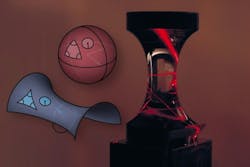2D optical model shows how light behaves in 4D curved spacetime
| A laser beam propagates along the 2D surface of a glass object shaped like an hourglass, curling once around the middle of the object. This is an example of an object with negative (saddle-shaped) surface curvature, in contrast to an object with positive surface curvature, such as a sphere. (Image: Vincent Schultheiß) |
Researchers at Friedrich-Alexander-Universität Erlangen-Nürnberg (FAU) and Friedrich Schiller University Jena (both in Germany) have created 2D optical analogues of 4D spacetime to help in understanding the path of light through space under the influence of gravity under Einstein's general theory of relativity.1
Instead of changing all four dimensions of spacetime, they reduced the problem to two dimensions and studied the propagation of light along the somoth curved surfaces of transparent optical shapes. Laser light was made to follow the surface in a way similar to that of a whispering-gallery resonator.
The surfaces can be made with positive (pink in the figure) or negative (blue in the figure) curvature. They are designed to have a constant Gaussian curvature (which is the product of the two principal curvatures at a point). Both a positive and a negative curvature mimic universes where the cosmological constant is nonzero (our universe appears to have a cosmological constant of zero or very near to it).
Geodesics
Because light naturally travels the shortest path to its destination, the curve the laser light takes along the surface of the optic are geodesics, or the shortest paths between two points -- which often look anything but straight when viewed from the outside.
As the light propagates it behaves in the same way that it does when deflected by huge masses. By changing the curvature of the surface it is possible to control the propagation of light. Conversely, it is also possible to learn about the curvature of a surface itself by analyzing the propagation of light. When transferred to astronomical observations, this means that light arriving from far-off stars carries valuable information about the space that it has travelled through.
Studying spacetime via intensity interferometry
In other work, the researchers studied intensity interferometry, pioneered by the English physicists Robert Hanbury Brown and Richard Twiss, which is used to determine the size of stars that are close to the sun. In this measurement technique, two telescopes are set up some distance apart and focused on the star that is to be examined. The fluctuations in light intensity measured by the two telescopes are then compared. Fluctuations in intensity are a result of the interference of light emitted separately from the surface of the star and allow conclusions to be drawn about the size of the object that is observed.
As paths of light in curved space tend to converge or diverge much more frequently than in flat space, the size of the dots changes depending on the curvature. The researchers were able to show that knowing the curvature is crucial for interpreting results and that experiments that use interferometry are suitable for measuring the general curvature of the universe more exactly.
Other more practical uses?
The curved optical surfaces could be used to control light paths in optical systems, say the researchers. "Creating local variations in the surface curvature can often have the same effect as changing the volume material itself," says Ulf Peschel, a professor at Friedrich Schiller University Jena. "This could allow the number of steps required and materials used when manufacturing integrated optical circuits or micro-optic components to be reduced."
Source: http://www.fau.eu/2016/01/13/news/research/making-astronomical-observations-in-the-laboratory/
REFERENCE:
1. Vincent H. Schultheiß et al., Nature Photonics (2016); doi: 10.1038/nphoton.2015.244
